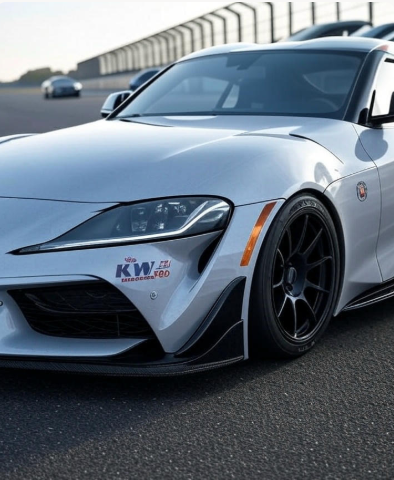Introduction
On May 26, 2025, Toyota Europe News Room announced the launch of two high-performance editions of the GR Supra: the A90 Final Edition and the Lightweight EVO, marking the end of the current generation of this iconic sports car. With the A90 Final Edition boasting 429 horsepower, a race-inspired KW suspension, and carbon-fiber aerodynamics, and the Lightweight EVO offering chassis and aero upgrades with 382 horsepower, these models push performance to new heights. However, their limited production only 300 units of the A90 Final Edition globally and high costs, alongside environmental concerns, have sparked global discussions, as seen in Google’s “People Also Asked\” section. How can Toyota balance exclusivity with accessibility while addressing sustainability?
The Problem: Challenges Facing the GR Supra A90 Final Edition and Lightweight EVO
While the GR Supra’s new editions showcase Toyota’s engineering prowess, they also highlight significant challenges that could limit their impact and raise broader concerns.
- Limited Availability and Exclusivity Concerns
The A90 Final Edition is restricted to just 300 units globally, with 150 allocated to Europe and 150 to Japan, sold through a lottery system. This exclusivity, while creating buzz, frustrates fans unable to access the car. The Lightweight EVO, though more accessible, is still a niche offering in Europe, leaving many enthusiasts in regions like the U.S. where the less powerful MkV Final Edition (382 hp) is sold feeling shortchanged. Posts on X reflect this sentiment, with users lamenting the lottery system and regional disparities. This limited availability risks alienating Toyota’s broader fanbase, a concern often raised in global searches about access to limited-edition vehicles.
- High Costs in a Competitive Market
The A90 Final Edition’s price tag of €142,800 in Europe (approximately $156,478 USD) makes it more expensive than a Porsche 911 Carrera 4 GTS, a direct competitor. Even the U.S. bound MkV Final Edition, at $69,085, is a significant investment compared to alternatives like the Nissan Z or Ford Mustang Mach 1. In India, where the GR Supra isn’t officially sold, import duties could push the A90’s price to over ₹2 crore (around $240,000 USD), far beyond the reach of most buyers. This pricing strategy, while justified by the car’s enhancements, limits its appeal in price-sensitive markets, a frequent topic in online discussions about the affordability of high-performance cars.
- Environmental Concerns and Sustainability Pushback
The GR Supra’s gas-powered B58 engine delivering 429 hp in the A90 Final Edition and 382 hp in the Lightweight EVO raises environmental concerns amid a global push for sustainability. With the EU aiming for carbon neutrality by 2050 and India targeting net-zero by 2070, high-performance gas vehicles face scrutiny. The carbon-fiber components, while lightweight, are energy-intensive to produce and difficult to recycle, further complicating the car’s environmental footprint. Posts on X highlight this tension, with some users questioning the relevance of gas-powered sports cars in an era of electrification, a concern often echoed in global queries about the auto industry’s green transition.
- Balancing Performance with Practicality
The A90 Final Edition’s race-inspired upgrades, like the KW suspension and Michelin Pilot Sport Cup 2 tires, prioritize track performance, but they may compromise daily drivability. The stiff suspension and low-profile tires are less suited for pothole-ridden roads in markets like India or rural Europe, where infrastructure varies widely. The Lightweight EVO, while more balanced, still focuses on driving dynamics over practicality, potentially alienating buyers seeking a versatile sports car. This trade-off between performance and usability is a common concern in online searches about the practicality of high-performance vehicles.

The Solution: Maximizing the GR Supra’s Legacy Responsibly
To address these challenges, Toyota can adopt strategies that balance exclusivity with accessibility, affordability with value, and performance with sustainability, ensuring the GR Supra’s final editions leave a lasting impact.
- Expanding Access Through Digital and Virtual Experiences
To mitigate the frustration of limited availability, Toyota should create digital and virtual experiences that allow fans to engage with the A90 Final Edition and Lightweight EVO. This could include a virtual reality (VR) test drive platform where users experience the cars’ performance on iconic tracks like the Nürburgring. Toyota Gazoo Racing could also launch an online configurator, letting fans customize their dream GR Supra and share it on social media, fostering a sense of involvement. For regions like the U.S., where the A90 isn’t available, Toyota could host exclusive showcase events, allowing enthusiasts to see the car in person. This approach addresses global concerns about accessibility, ensuring more fans feel connected to the Supra’s legacy.
- Introducing Flexible Pricing and Financing Options
To tackle the high cost, Toyota should offer flexible pricing and financing options, especially in price-sensitive markets. In Europe, where the A90 Final Edition costs €142,800, Toyota could introduce lease-to-own programs with low monthly payments, making the car more accessible to enthusiasts. In markets like India, where import duties inflate prices, Toyota could partner with local governments to reduce tariffs for limited-edition vehicles, positioning the Supra as a symbol of automotive innovation. For the Lightweight EVO, Toyota could offer a base model with optional performance packs, allowing buyers to customize their car within budget. This strategy answers global questions about affordability, broadening the Supra’s appeal without sacrificing its premium status.
- Incorporating Sustainable Practices and Hybrid Options
To address environmental concerns, Toyota should integrate sustainable practices into the GR Supra’s production and explore hybrid technology for future models. For the A90 Final Edition and Lightweight EVO, Toyota could offset carbon emissions by investing in renewable energy projects, such as solar farms, to power its manufacturing plants. The carbon-fiber components could be sourced from recycled materials, reducing their environmental impact. Looking ahead, Toyota could develop a hybrid GR Supra variant, combining the B58 engine with an electric motor to reduce emissions while maintaining performance similar to the tech in Toyota’s electrified vehicles produced in North Carolina starting in 2025. This approach addresses global concerns about sustainability, aligning the Supra with the auto industry’s green shift.
- Enhancing Practicality Without Sacrificing Performance
To balance performance with practicality, Toyota should offer adjustable suspension settings for the A90 Final Edition and Lightweight EVO, allowing drivers to switch between track-focused and comfort modes. This would make the cars more versatile for varied road conditions, such as India’s uneven terrain or Europe’s cobblestone streets. The Lightweight EVO could include a “daily driver” package with slightly softer tires and a more compliant suspension, catering to buyers who want performance without sacrificing usability. Toyota could also provide aftermarket support, offering parts like all-season tires for owners in challenging climates. This solution addresses global queries about the practicality of high-performance cars, ensuring the Supra appeals to a wider audience.
- Leveraging the Supra’s Legacy for Educational Outreach
Finally, Toyota should leverage the GR Supra’s legacy to inspire the next generation of engineers and enthusiasts through educational outreach. Toyota Gazoo Racing could partner with universities in Europe, Japan, and India to host workshops on automotive engineering, using the A90 Final Edition as a case study in performance design. Virtual lectures on aerodynamics, suspension tuning, and sustainable manufacturing could be streamed globally, engaging students and fans alike. Toyota could also sponsor motorsport events featuring the Lightweight EVO, showcasing its capabilities while promoting STEM education. This initiative answers global curiosity about the technology behind the Supra, ensuring its legacy extends beyond the car itself.
Future Outlook
Implementing these solutions faces hurdles. Virtual experiences require significant investment in technology, and flexible pricing may reduce profit margins. Sustainable practices, like carbon offsetting, demand long-term commitment, and hybrid technology could delay future Supra models. Enhancing practicality risks diluting the car’s track-focused appeal, and educational outreach requires coordination across regions. However, as the GR Supra bows out, these strategies can cement its legacy as a symbol of innovation and accessibility. With Toyota’s North Carolina plant set to produce batteries for electrified vehicles in 2025, the next Supra generation could embrace electrification, blending performance with sustainability for a new era.
Insights
The Toyota Europe News Room’s announcement on May 26, 2025, of the GR Supra A90 Final Edition and Lightweight EVO highlights the pinnacle of performance engineering, but also underscores challenges like limited availability, high costs, and environmental concerns. By expanding access through digital experiences, offering flexible pricing, adopting sustainable practices, enhancing practicality, and leveraging the Supra’s legacy for education, Toyota can address these global concerns. As of May 27, 2025, the GR Supra’s final editions offer a chance to not only push performance limits but also set a precedent for how iconic cars can evolve responsibly, ensuring their legacy endures for generations to come.



